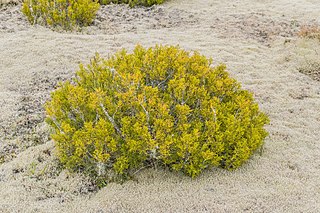
Halocarpus bidwillii, commonly known as the mountain pine or bog pine, is a species of conifer in the family Podocarpaceae. It is endemic to New Zealand.
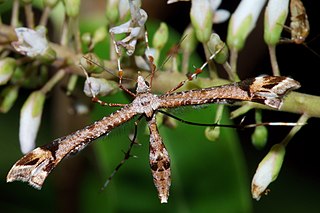
Amblyptilia falcatalis, the common Hebe plume moth, is a species of moth of the family Pterophoridae. This species was first described by Francis Walker and is endemic to New Zealand. This species can be found in both the North and South Islands. The larval host plants are in the Veronica genus and include Veronica stricta,Veronica salicifolia,Veronica elliptica, Veronica macrocarpa and Veronica speciosa. This moth likely has two broods a year and adults have been observed all year round.

Zealandopterix zonodoxa is a moth of the family Micropterigidae. It endemic to New Zealand and is found from the Hawkes Bay north as well as on Poor Knights, Little Barrier and Great Barrier Islands. It is the smallest micropterigid in New Zealand and the shiny white markings on the forewing of this species are variable. It is a day flying moth, but has been collected using UV light. Adults are on the wing from September to March and the species has been witnessed visiting the flowers of Nikau and Cordyline pumilio in large numbers. It inhabits a wide variety of moist indigenous forest but is associated with forests in which podocarps are common. Larvae have been sieved from rotten wood on the floor of a mixed podocarp/broadleaf forest or extracted from moss or from bryophytes.
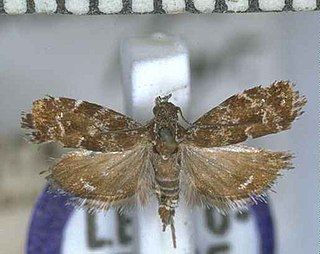
Asterivora analoga is a moth of the family Choreutidae. It is endemic to New Zealand and has been observed in both the North and South Islands. Adults are on the wing in December and January.
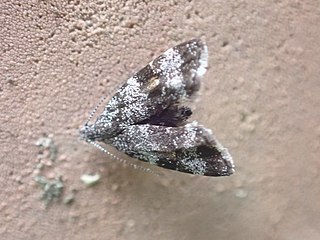
Asterivora antigrapha is a moth in the family Choreutidae. It is endemic to New Zealand and has been observed in the North and South Island. This species inhabits the edge of scrubland. The adults are on the wing in November and December. This species can be found flying the day. It has been hypothesised that this species hibernates over winter.

Asterivora nivescens is a species of moth in the family Choreutidae. It is endemic to New Zealand and has been observed in Nelson. This species inhabits native herbage on mountain sides. Adults of this species are on the wing in January.
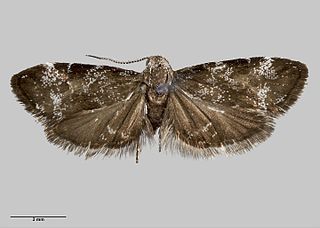
Asterivora tristis is a species of moth in the family Choreutidae. It is endemic to New Zealand and has been observed in Tongariro National Park. Adults of this species are on the wing in January.

Asterivora oleariae is a species of moth in the family Choreutidae. It is endemic to New Zealand and can be found on Stewart Island, Big South Cape Island and The Snares. There is one generation a year on The Snares with adults being on the wing in January and February. Larvae are feed on plants in the Olearia genus.

Hierodoris atychioides is a moth of the family Oecophoridae. It was described by Arthur Gardiner Butler in 1877. The female holotype specimen held at the Natural History Museum, London. This species is endemic to New Zealand, and can be found in the North, South and Stewart Islands. The larvae form webs of silk attached to frass and leaves on their hosts in which they shelter, often in the company of other larvae in their species. Their feeding habits have not been observed in detail but Hoare hypothesises the larvae may feed on dead or dying leaves. The larvae feed on a wide range of trees and shrubs, including Dacrydium cupressinum, Prumnopitys taxifolia, Dacrycarpus dacrydioides, Libocedrus bidwillii, Cupressus macrocarpa, Leptospermum scoparium, Kunzea ericoides, Ozothamnus leptophyllus, Abies, Picea, Pinus and Thuja species. Although they are regarded as a pest of exotic forests in New Zealand, the economic damage the larvae cause is minimal and they tend to be controlled only by their natural enemies. Larval enemies include the parasitic flies Trigonospila brevifacies and Pales funesta as well as parasitic wasps including Xanthopimpla rhopaloceros. The adult moths are day flying and are most common during the months of December and January. This species is variable in appearance as larvae, pupa and as adults, and it has been hypothesised that it is in the process of speciation.

Hierodoris illita is a moth of the family Oecophoridae. It is endemic to New Zealand and is found in both the North and South Islands. However this species has not been recorded at Stewart Island / Rakiura.
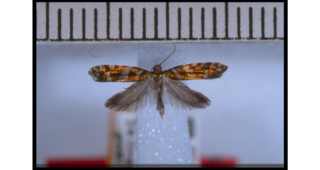
Chrysorthenches argentea is a species of moth in the family Plutellidae. It was described by John S. Dugdale in 1996. It is endemic to New Zealand and has been observed in the Buller District and at the West Coast.

Hierodoris frigida is a moth of the family Oecophoridae. It is endemic to New Zealand and is only found in the South Island. This species is found in two parts of that island, the Nelson/Tasman area and the Mackenzie, Otago and Dunedin areas in the southern part of the island. Although similar to H. iophanes this species can be distinguished as H. frigida has white bands on its forewings and the metallic coloured areas differ in placement. Segment 2 on the labial palp is entirely yellow and enables this species to be distinguished from the similar appearing species H. polita and H. torrida. Larvae have been collected amongst leaf litter from beneath species within the genus Thymus. It prefers open and shrubland habitats and adult moths have been observed flying close to the soil underneath Leptospermum scrub.

Tortrix fervida is a species of moth of the family Tortricidae. It is endemic to New Zealand and has been observed in both the North and South Islands. The larvae feed on species of fern in the genus Hymenophyllum including Hymenophyllum nephrophyllum. The adult moths are variable in appearance and are day flying. They are on the wing from November until January. This species is regarded as being uncommon.

Chalastra aristarcha, the silver fern moth, is a moth of the family Geometridae. This species was first described by Edward Meyrick in 1892. It is endemic to New Zealand and is found in the North Island. This species inhabits dense native forest. The larvae feed on the species host plant, the Silver fern, during spring. This species then pupates on top of leaf litter or moss on the ground. The pupation state lasts for approximately 6 weeks. Adult moths are on the wing from October until April but can sometimes also be seen during the winter months. Adults can be disturbed from silver ferns during the day or are seen on the wing at night particularly at Metrosideros perforata when in flower. Adults are attracted to light. It has been hypothesised that the range of C. aristarcha has restricted as a result of urban development and land conversion of its habitat.
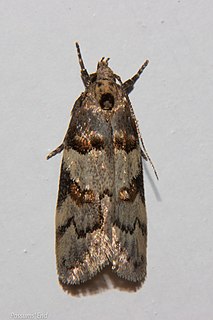
Trachypepla contritella, the Kiwi Enigma, is a species of moth in the family Oecophoridae. Originally endemic to New Zealand this species can be found throughout that country. However, from 2012 this species has been also been recorded in the United Kingdom. The preferred habitat of T. conritella is New Zealand native forest and larvae of this species are litter leaf feeders. Adults are on the wing from November to February in New Zealand and are attracted to light.
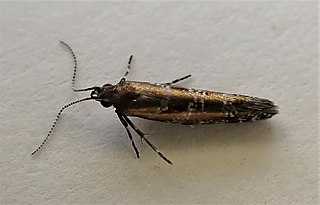
Chrysorthenches drosochalca is a species of moth in the family Plutellidae first described by Edward Meyrick in 1905. It is endemic to New Zealand and has been found in the North and South Islands. The larvae are leaf miners of Prumnopitys ferruginea. Adults are on the wing from January to March.
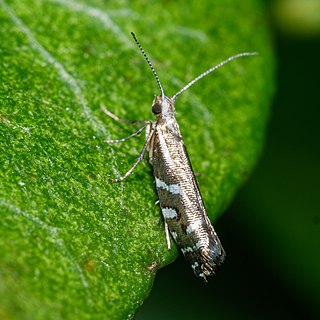
Chrysorthenches glypharcha is a species of moth in the family Plutellidae. It was first described by Edward Meyrick in 1919. It is endemic to New Zealand and is found in the North and South Islands. This species inhabits native forest with Podocarpus trees present. The larva and pupa of this species is currently unknown but the adults are on the wing in February, October and November. The adult moths are associated with Podocarpus totara and Podocarpus laetus.

Chrysorthenches phyllocladi is a species of moth in the family Plutellidae. It was first described by John S. Dugdale in 1996. It is endemic to New Zealand and has been observed in both the North and South Islands. The larvae of this species feed on Phyllocladus alpinus. Adults have been observed on the wing in February, April and November.

Chrysorthenches polita is a species of moth in the family Plutellidae. It was first described by Alfred Philpott in 1918. It is endemic to New Zealand and it has been observed in both the North and South Islands. This species likely has two broods a year with one emerging in late spring and other in summer. The larvae mine leaves of Podocarpus species including Podocarpus totara. Adults have been observed on the wing in July to October and December to March.

Chrysorthenches is a genus of moths of the family Plutellidae.






















